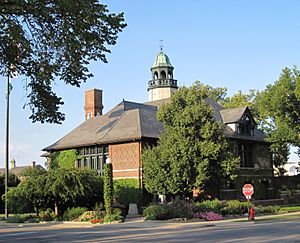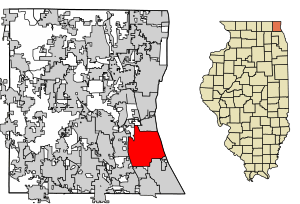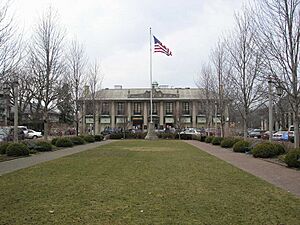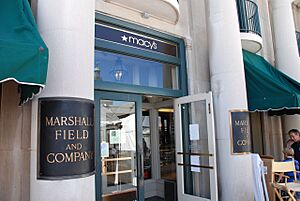Lake Forest, Illinois facts for kids
Quick facts for kids
Lake Forest, Illinois
|
|
|---|---|

Lake Forest City Hall
|
|

Location of Lake Forest in Lake County, Illinois.
|
|
| Country | United States |
| State | Illinois |
| County | Lake |
| Township | Moraine, Shields, Vernon, West Deerfield |
| Founded | 1857 |
| Incorporated | 1861 |
| Government | |
| • Type | Council-manager |
| Area | |
| • Total | 17.27 sq mi (44.72 km2) |
| • Land | 17.20 sq mi (44.55 km2) |
| • Water | 0.07 sq mi (0.17 km2) |
| Population
(2020)
|
|
| • Total | 19,367 |
| • Density | 1,125.99/sq mi (434.74/km2) |
| Time zone | UTC−6 (CST) |
| • Summer (DST) | UTC−5 (CDT) |
| ZIP Code |
60045
|
| Area codes | 847, 224 |
| FIPS code | 17-41105 |
| Wikimedia Commons | Lake Forest, Illinois |
Lake Forest is a city in Lake County, Illinois, United States. In 2020, about 19,367 people lived there. The city is on the shore of Lake Michigan. It is part of the larger Chicago metropolitan area and the North Shore.
Lake Forest was started in 1857 along with Lake Forest College. It was a stopping point for people traveling south to Chicago. The Lake Forest City Hall was finished in 1898. It was designed by Charles Sumner Frost. The building first held the fire department, the Lake Forest Library, and city offices.
Contents
History of Lake Forest
Early Beginnings
The Potawatomi people lived in Lake County before 1836. The United States government then made them move west of the Mississippi River.
When Lake Forest was first planned in 1857, its roads were designed to limit outside traffic. This helped keep the peaceful settlement separate from nearby areas. Today, the town is easier to reach. However, the older part of eastern Lake Forest, near Lake Michigan, is still quite private. It is known for its beautiful scenery, history, and special buildings.
Famous architects like Howard Van Doren Shaw, David Adler, and Frank Lloyd Wright designed homes here. Landscape designers Frederick Law Olmsted and Jens Jensen also worked on projects in Lake Forest. Market Square, a shopping area, was completed in 1916. It was designed by Howard Van Doren Shaw.
Lake Forest had an African-American community from its early days. People came for jobs on the large estates and at schools in the late 1800s. Unlike some other towns, Lake Forest had many people who supported the Abolitionist movement. Sylvester Lind, Lake Forest's first mayor and a founder of Lake Forest College, helped enslaved people escape on the Underground Railroad. Roxana Beecher, a niece of abolitionist Harriet Beecher Stowe, taught in a school that welcomed all students.
Samuel Dent, an escaped slave and Union veteran, was an early businessman. He ran a stable for horses and carriages. A local jazz band was even named after him. Julian Matthews and his wife Octavia ran a bakery, restaurant, and ice cream shop. Walker Sales, a Black man from Kentucky, became the second police officer in Lake Forest in 1900. He served for almost 20 years.
The African Methodist Episcopal Church was started by this community in 1866. By 1900, the First Baptist Church of Lake Forest also opened and is still active today. By the 1980s, some older Black residents sold their homes due to rising prices, but others stayed. Lake Forest also had a small Jewish community, including wealthy people like Albert Lasker and David Adler.
The early settlers of Lake Forest wanted a quiet place away from Chicago. They felt Chicago was becoming too crowded with new immigrants and different ideas. Country clubs became important social spots. The Onwentsia Club was a very popular club for sports and social events in the Midwest.
Growing Over Time
Starting in the 1950s, Lake Forest grew a lot. This was because of new building projects and adding nearby areas. The city limits expanded westward. The area now called "West Lake Forest" began as a small community named Everett. Many Irish farm workers lived there.
This growth caused some debate. Many residents felt the town was losing its unique feel. The city government said the expansion was needed to stop unwanted businesses from coming too close to the community.
One special thing about Lake Forest is its natural areas. In 1967, a group of 12 residents started the Lake Forest Open Lands Association. Their goal was to buy or protect the disappearing open spaces in the city. They wanted to save animal habitats, bring back natural ecosystems, and teach children about nature.
Over 38 years, this group gained more than 700 acres (2.8 km²) within the city. These areas are now six nature preserves with 12 miles (19 km) of walking trails open to everyone. These preserved lands include wetlands, original prairie from before 1830, woodland, and savanna.
The restoration of these lands is celebrated each September with an event called "Bagpipes and Bonfire." It started as a community event where controlled fires were used to clear brush and help the savanna grow. Bagpipes have always been part of the gathering because many early residents were of Scottish-Irish descent. This event also helps raise money for the Lake Forest Open Lands Association.
Lake Forest is home to the Gorton Center. This building was originally the town's first school (K-8). Today, Gorton is a center for arts and culture. It hosts live music, storytelling, and events for children and the community. It also has a film program and offers classes for all ages. The original building was designed in 1901 by James Gamble Rogers.
The Ragdale Foundation, a place for artists to live and work, is also in Lake Forest. It was once the summer home of architect Howard Van Doren Shaw, built in 1897. Famous artist Sylvia Shaw Judson stayed there.
In 1992, Lake Forest made news when it tried to ban the sale of certain music to people under 18.
Lake Forest has been named a Tree City USA by the National Arbor Day Foundation. This shows its dedication to caring for its trees. In 2006, the city had received this honor for 26 years. Actor Mr. T caused a stir when he cut down over 100 oak trees on his property. This event is sometimes called the "Lake Forest Chain Saw Massacre."
Geography
Lake Forest is located in the North Shore area of Chicago.
In 2010, Lake Forest had a total area of about 17.25 square miles (44.7 km²). Most of this area, about 17.18 square miles (44.5 km²), is land. The rest, about 0.07 square miles (0.18 km²), is water.
Economy

Lake Forest has three main business areas. Two of these areas have public train stations. The central business district has a Metra commuter train station. This area has many shops, banks, offices, and restaurants. Market Square is part of this area.
Another business district to the west also has a Metra train station. It offers a mix of shops, banking, and restaurants. A third business area is mostly for company offices. It is located near the city's northwestern border with the Tri-State Tollway.
Several large companies have their main offices in Lake Forest. These include Fortune 500 companies like Tenneco, Brunswick, and Hospira. Other companies like Akorn, Covered Logistics, Horizon Therapeutics, IDEX, Packaging Corporation of America, Pactiv, Prestone, and Trustmark are also based here.
The Chicago Bears football team's training facility and headquarters, Halas Hall, opened in west Lake Forest in 1997. The Chicago Fire soccer team now trains at the Bears' old facility on the campus of Lake Forest.
Major Employers
Here are the top employers in Lake Forest as of 2020:
| # | Employer | # of Employees |
|---|---|---|
| 1 | Northwestern Lake Forest Hospital | 1,395 |
| 2 | Pfizer | 700 |
| 3 | Abbott | 826 |
| 4 | Trustmark Insurance Company | 712 |
| 5 | Lake Forest College | 415 |
| 6 | Pactiv | 388 |
| 7 | Lake Forest Elementary School District 67 | 321 |
| 8 | Packaging Corporation of America | 298 |
| 9 | Lake Forest Community High School District 115 | 275 |
| 10 | City of Lake Forest | 210 |
Demographics
| Historical population | |||
|---|---|---|---|
| Census | Pop. | %± | |
| 1880 | 877 | — | |
| 1890 | 1,203 | 37.2% | |
| 1900 | 2,215 | 84.1% | |
| 1910 | 3,349 | 51.2% | |
| 1920 | 3,657 | 9.2% | |
| 1930 | 6,554 | 79.2% | |
| 1940 | 6,885 | 5.1% | |
| 1950 | 7,819 | 13.6% | |
| 1960 | 10,687 | 36.7% | |
| 1970 | 15,642 | 46.4% | |
| 1980 | 15,245 | −2.5% | |
| 1990 | 17,836 | 17.0% | |
| 2000 | 20,059 | 12.5% | |
| 2010 | 19,375 | −3.4% | |
| 2020 | 19,367 | 0.0% | |
| U.S. Decennial Census 2010 2020 |
|||
Population Makeup
| Race / Ethnicity (NH = Non-Hispanic) | Pop 2010 | Pop 2020 | % 2010 | % 2020 |
|---|---|---|---|---|
| White alone (NH) | 17,474 | 16,380 | 90.19% | 84.58% |
| Black or African American alone (NH) | 196 | 232 | 1.01% | 1.20% |
| Native American or Alaska Native alone (NH) | 19 | 17 | 0.10% | 0.09% |
| Asian alone (NH) | 899 | 1,114 | 4.64% | 5.75% |
| Pacific Islander alone (NH) | 1 | 3 | 0.01% | 0.02% |
| Some Other Race alone (NH) | 21 | 62 | 0.11% | 0.32% |
| Mixed Race or Multi-Racial (NH) | 223 | 645 | 1.15% | 3.33% |
| Hispanic or Latino (any race) | 542 | 914 | 2.80% | 4.72% |
| Total | 19,375 | 19,367 | 100.00% | 100.00% |
In 2010, there were 19,375 people in Lake Forest. Most residents were White (92.11%). About 4.67% were Asian, and 2.80% were Hispanic or Latino.
In 2000, there were 20,059 people and 6,687 households. About 39% of households had children under 18. The average household had 2.78 people. The median age in the city was 41 years old.
Transportation
Lake Forest can be reached by the Tri-State Tollway (I-94). The Skokie Highway (U.S. Highway 41) also runs through the city. Illinois Route 60 connects Lake Forest to western suburbs.
The city has two Metra commuter train stations, both named Lake Forest. The Union Pacific North Line has a station in East Lake Forest. The Milwaukee District North Line has a station in West Lake Forest. The Fort Sheridan station is just outside the city limits.
Education
Most students in Lake Forest go to schools in Lake Forest School District 67 and Lake Forest High School. Lake Forest High School also serves parts of nearby Lake Bluff.
Another school district, Rondout School District 72, serves eastern parts of Libertyville and some areas of Lake Forest and Lake Bluff. It has one school, Rondout Elementary School, for grades K-8. After graduating, students attend Libertyville High School.
Elementary and Middle Schools
- Rondout Elementary School (public)
- Deer Path Middle School (public)
- Cherokee Elementary School (public)
- Everett Elementary School (public)
- Sheridan Elementary School (public)
- Lake Forest Country Day School (private)
- School of St. Mary (private)
- East Lake Academy (private)
- Montessori School of Lake Forest (private; Montessori)
- Forest Bluff School (private; Montessori; in Lake Bluff; many students from Lake Forest)
High Schools
-
 During the early 2019 cold wave Lake Michigan froze as temperatures plunged below 0 °F (−18 °C) for nearly 48 hours.
During the early 2019 cold wave Lake Michigan froze as temperatures plunged below 0 °F (−18 °C) for nearly 48 hours. - Lake Forest High School (public)
- Lake Forest Academy (private)
- Woodlands Academy of the Sacred Heart (private)
Colleges
- Lake Forest College
- Lake Forest Graduate School of Management
Culture and Activities
Lake Forest is home to the Gorton Center, which includes the John & Nancy Hughes Theater. It also houses the Citadel Theatre Company and the Music Institute of Chicago Lake Forest Campus.
The city is known for its country clubs, such as the Onwentsia Club, Knollwood Club, Conway Farms Golf Club, the Lake Forest Winter Club, and the Lake Forest Club.
Polo in Lake Forest
Lake Forest is famous in the Chicago area for its history with the sport of polo. It was once the westernmost place where polo was played in the United States. In August 1933, the Onwentsia Club hosted a major polo event. It was called the "World Series of Polo" by the news. The best polo players from the eastern and western United States competed. Thousands of people came to watch these matches.
The event was described as a "shining moment" for American polo. Today, polo is still played yearly throughout August in Lake Forest.
Notable People
See also
 In Spanish: Lake Forest (Illinois) para niños
In Spanish: Lake Forest (Illinois) para niños






